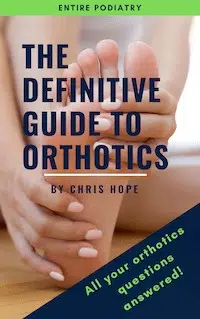What are Shin Splints?
Shin splints or Medial Tibial Stress Syndrome (MTSS) are a common cause of leg pain that often affects athletes and runners but can develop in anyone. Shin Splints is the broad term used to describe pain anywhere along the shin bone from the knee to the ankle. Most often pain is felt about halfway down the shin. Read more about shin splint pain.
Shin splints are a result of connective muscle tissue in the lower leg becoming inflamed and causing pain. Shin splints that are left untreated for a long period of time can progress to tibial stress fractures.
The term ‘Shin Splints’ is used to cover different injuries to different types of tissue in your leg. It’s important that your podiatrist conduct a thorough assessment to ensure the correct diagnosis, as treatment will be different depending on what tissue is affected.
- Muscle
- The cause of you shin pain may be due to pain in the muscles around your shin. These muscles work very hard with running and are prone to overuse, tightness and weakness.
- Periosteum
- The periosteum is the thin tissue layer that wraps around the tibia. Its role is to join the muscles to the bone. When the shin muscles are pulling too hard on the tibia the periosteum becomes injured and inflamed.
- Bone
- The cause of your shin pain may be due to the shinbone (the tibia) itself. This can lead to a stress fracture of the tibia.
Your shin pain may be a combination the above i.e. the muscle and the periosteum may be injured. Or your Shin Splints may progress from one tissue type to the next. For example if the shin muscles are tight they can be prone to overuse, this overuse can cause them to pull too hard on their insertion to the bone (the periosteum) and this pulling overtime can cause a stress fracture of the bone.
Shin Splints from walking
Typically Shin Splints are associated with running. But it is very possible for Shin Splints to develop from walking. This can occur after long distance walks or hikes but may also occur after walking without strenuous exercise.
As we walk we put stress and strain through our shinbone and muscles. If this stress is more than the tissue can tolerate then pain and injury will occur.
Treatment is the same for Shin Splints resulting from either walking or running. Ensuring you are in correct shoes is of particular importance when treating Shin Splints that occur when walking. Often it’s easy to remember to wear a good supportive shoe when we exercise but it can be difficult to ensure we are in good shoes at other times too. (Link to footwear)
If you are getting shin pain when walking we recommend you bring in your work shoes to the podiatrist for an assessment as they can give you recommendations of footwear that will give you better cushioning and support whilst suiting your personal preferences and requirements.
Shin Splints and running
Shin Splints from running are a very common condition we treat at Entire Podiatry and we have a lot of success with conservative treatment. If you are a runner it is important that your pain is assessed thoroughly to confirm the diagnosis of Shin Splints. It is also very important to consider your running shoes and to assess your running and walking “gait.”
If your Shin Splints develop while running then a running gait assessment may reveal ways that your running technique can be modified to reduce the strain on your shinbone.
The podiatrist will also look at your lower-limb muscle strength and flexibility as well as your shoes and training program to see what elements can be modified and improved.
If the podiatrist considers your foot biomechanics to be an important contributory factor to the development of your Shin Splints they may consider orthotics (link to orthotics), and/or a recommend different type of shoe.
At Entire Podiatry, the orthotics that are prescribed to treat Shin Splints are very specific to your running gait, biomechanics and footwear. We will design a specific orthotic to be used only in your running shoes and the prescription will be designed to reduce the tension on the muscles causing the pain when you run. It is important that the orthotic is matched to your running shoes to ensure that you have the ideal amount of support and correction.
Shin Splints in pregnancy
Shin Splints may occur during pregnancy as the sudden increase in body weight places more force through your feet and legs. The hormonal changes associated with pregnancy cause the ligaments throughout your body to loosen. This can cause the ligaments in your feet to stretch and you feet can ‘roll-in’ or ‘over-pronate’ This ‘over pronation’ can cause the muscles that attach to the shinbone to be overused which can lead to Shin Splints.
Treatment of Shin Splints during pregnancy follows the same general treatment protocol, however care should be taken to ensure any pain management medication is safe.
How long do Shin Splints last?
Initially, your Shin Splints may disappear a few minutes into the activity once the muscles and legs are ‘warmed up.’ This can give a false sense that Shin Splints in general will ‘go away’, but this is not the case. If Shin Splints are not treated then the damage progresses. This means that it will typically take more time for the pain to go away, the pain tends to be more severe and the pain is worse for longer periods after the activity. Shin Splints can progress to a constant pain which wont go away after warming up and can be painful even without exercise.
Shin Splints that are left untreated for a long period of time can progress from an irritation and inflammation of your muscles and soft tissue to a stress fracture of your tibia! This occurs when the force and strain going through the tibia is so much that the bone fractures. If this is occurs it may take up to 6-8 weeks of wearing a pneumatic walking cast and being completely off your foot and leg for this is heal! Listen to your body and begin treatment as soon as you notice signs of pain.
Shin Splints that keep coming back
It is not uncommon to have Shin Splints return. This usually happens for one of the following reasons
- The ‘cause’ of your Shin Splints was not adequately addressed. E.g. is the way that your foot works as you walk/run causing the muscles in your shin to be overused? Are you in the wrong shoes? Do you need orthotics to address your biomechanics and reduce strain through your shins? If so, it is vital that all of these considerations have been properly addressed to prevent recurrence.
- Too quick to return to sport. Most often adequate rest from the activity that aggravates the shin pain will relieve the symptoms. However once the symptoms have settled its important to reintroduce the activity slowly. The frequency, intensity and duration of the activity will all need to be modified to allow a gradual return to sport to reduce the risk of on-going issues.
- Beginning the season again after the off-season. The beginning of the season usually means a sudden increase in training. Ensuring that you continue to engage in some kind of exercise over the off-season will reduce the chance of Shin Splints occurring.
How can I prevent Shin Splints?
We know that prevention is always better than cure. To prevent Shin Splints from becoming a problem for you, here are Entire Podiatry’s top 5 tips…
- Ensure you wear appropriate footwear
- Perform muscle-strengthening exercises
- Ensure any increases in activity levels are gradual
- Avoid running on hard or inclined surfaces
- Stretch your calf muscles
Read more in our top tips for preventing shin splints.
For more information about treatment and prevention of shin splints, call 1800-4-ENTIRE or book an appointment online.
Further Reading




